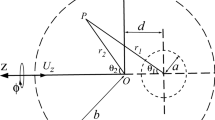Abstract
Stokes incompressible viscous fluid flow through a permeable spheroidal particle which is a bit deformed from the shape of a sphere is studied and solved analytically. It consists of two regions, porous region which obeys Darcy’s law and liquid region in which Stokes approximation is used. Boundary conditions used at the interface are mass conservation, balance of normal stress, and Beavers–Joseph–Saffman–Jones condition. Expression for drag which acts on the spheroid is obtained and well known results are deduced in the limiting cases. Variation of drag coefficient with various parameters like deformation, slip, permeability, no slip are shown by graphs.




Similar content being viewed by others
References
Darcy, H.P.G.: Les fontaines publiques de la ville de dijon. Proc. R. Soc. Lond. Ser. 83, 357–369 (1910)
Brinkman, H.C.: A calculation of viscous force exerted by a flowing fluid on dense swarm of particles. Appl. Sci. Res. A 1(1), 27–34 (1947)
Leonov, A.I.: The slow stationary flow of a viscous fluid about a porous sphere. J. Appl. Maths. Mech. 26, 564–566 (1962)
Joseph, D.D., Tao, L.N.: The effect of permeability on the slow motion of a porous sphere. Z. Angew. Math. Mech. 44, 361–364 (1964)
Sutherland, D.N., Tan, C.T.: Sedimentation of a porous sphere. Chem. Eng. Sci. 25, 1948–1950 (1970)
Neale, G., Epstein, N.: Creeping flow relative to permeable spheres. Chem. Eng. Sci. 28, 1865–1874 (1973)
Jones, I.P.: Low Reynolds number flow past a porous spherical shell. Proc. Camb. Philos. Soc 73, 231 (1973)
Feng, Z.G., Michaelides, E.E.: Motion of a permeable sphere at finite but small Reynolds numbers. Phys. Fluid. 10, 6 (1998)
Jager, W., Mikelic, A.: On the interface boundary condition of Beavers, Joseph, and Saffman. SIAM J. Appl. Math. 60(4), 1111–1127 (2000)
Vainshtein, P., Shapiro, M., Gutfinger, C.: Creeping flow past and within a permeable spheroid. Int. J. Multiph. 28, 1945–1963 (2002)
Srinivasacharya, D.: Flow past a porous approximate spherical shell. Z. Angew. Math. Phys. 58, 646–658 (2007)
Beavers, G.S., Joseph, D.D.: Boundary condition at a naturally permeable wall. J. Fluid Mech. 30, 197 (1967)
Urquiza, J.M., N’Dri, D., Garon, A., Delfour, M.C.: Coupling Stokes and Darcy equations. Appl. Numer. Math. 58, 525–538 (2008)
Shapovalov, V.M.: Viscous fluid flow around a semipermeable sphere. J. Appl. Mech. Tech. Phys. 50(4), 584–588 (2009)
Cao, Y., Gunzburger, M., Hua, F., Wang, X.: Coupled Stokes–Darcy model with Beavers–Joseph interface boundary condition. Commun. Math. Sci. 8(1), 1–25 (2010)
Vereshchagin, A.S., Dolgushev, S.V.: Low velocity viscous incompressible fluid flow around a hollow porous sphere. J. Appl. Mech. Techn. Phys. 52(3), 406–414 (2011)
Prakash, J., Raja Sekhar, G.P., Kohr, M.: Stokes flow of an assemblage of porous particles: stress jump condition. Z. Angew. Math. Phys. 62, 1027–1046 (2011)
Prakash, J., Raja Sekhar, G.P.: Estimation of the dynamic permeability of an assembly of permeable spherical porous particles using the cell model. J. Eng. Math. 80, 63–73 (2013)
Saffman, P.G.: On the boundary condition at the surface of a porous medium. Stud. Appl. Math. 50, 93 (1971)
Saad, E.I.: Stokes flow past an assemblage of axisymmetric porous spheroidal particle in cell models. J. Porous Media. 15(9), 849–866 (2012)
Chen, P.C.: Fluid extraction from porous media by a slender permeable prolate-spheroid. Extreme Mech. Lett. 4, 124–130 (2015)
Rasoulzadeh, M., Kuchuk, F.J.: Effective permeability of a porous medium with spherical and spheroidal vug and fracture inclusion. Transp. Porous Med. 116, 613–644 (2017)
Tiwari, A., Yadav, P.K., Singh, P.: Stokes flow through assemblage of nonhomogeneous porous cylindrical particle using cell model technique. Natl. Acad. Sci. Lett. 4(1), 53–57 (2018)
Khabthani, S., Sellier, A., Feuillebois, F.: Lubricating motion of a sphere towards a thin porous slab with Saffman slip condition. J. Fluid Mech. 867, 949–968 (2019)
Lai, M.C., Shiue, M.C., Ong, K.C.: A simple projection method for the coupled Navier–Stokes and Darcy flows. Comput. Geosci. 23, 21–33 (2019)
Happel, J., Brenner, H.: Low Reynolds Number Hydrodynamics. Prentice-Hall, Englewood Cliffs, NJ (1965)
Nield, D.A., Bejan, A.: Convection in Porous Media. Studies in Applied Mathematics, 3rd edn. Springer, New York (2006)
Author information
Authors and Affiliations
Corresponding author
Additional information
Publisher's Note
Springer Nature remains neutral with regard to jurisdictional claims in published maps and institutional affiliations.
Appendix
Appendix
On applying the Eqs. (21) to (23) upto first order of \(\alpha _{m}\), we obtain the following equations
Solving the leading terms of Eqs. (48) to (50), we get the values of \(a_2\), \(b_2\), and \(c_2\) as
In order to calculate other arbitrary constants \(A_n\), \(B_n\), and \(C_n\),we require the following identities
By taking the use of these identities in Eqs (43) to (45) we see that the values of \(A_n\), \(B_n\) and \(C_n\) \(=0\) for \(n\ne m-2,m,m+2\) and for \(n=m-2,m,m+2\) we have the following expressions
where
and
The expression for \(B_2\) is
Rights and permissions
About this article
Cite this article
Madasu, K.P., Bucha, T. Steady Viscous Flow Around a Permeable Spheroidal Particle. Int. J. Appl. Comput. Math 5, 109 (2019). https://doi.org/10.1007/s40819-019-0692-1
Published:
DOI: https://doi.org/10.1007/s40819-019-0692-1



